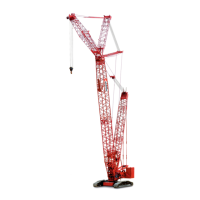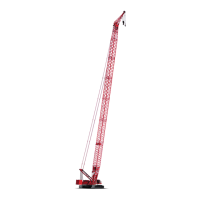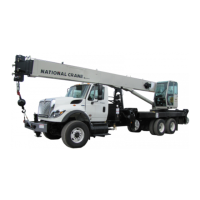Manitowoc Published 12-05-17, Control # 032-23 2-9
18000 OPERATOR MANUAL SAFETY INFORMATION
SAFE OPERATING PRACTICES
General
The importance of safe operation cannot be over
emphasized. Carelessness and neglect on the part of
operators, supervisors and planners, rigging personnel and
job site personnel can result in their death or injury and costly
damage to the crane or property.
The safety information in this publication is intended only as
a guide to assist qualified operators in safe operation.
Manitowoc cannot foresee all hazards that will arise in the
field; therefore, safety remains the responsibility of crane
operators and owner.
Local, state, and other governmental agencies may require
stricter operating practices. When a conflict in practices
exists, follow the strictest practice.
Read Operator Manual
Safe and efficient assembly, disassembly, and operation of
this crane requires that it be maintained in proper working
order and that its operators and maintenance personnel be
familiar with the crane's functions and capabilities.
The Operator Manual supplied with and considered part of
your crane shall be read and completely understood by each
person responsible for assembly, disassembly, operation,
and maintenance of the crane.
The Operator Manual shall be read to personnel who cannot
read or understand English or other language the manual is
translated into.
Because of a program of continuing improvement in product
design, Manitowoc reserves the right to change the
information and specifications contained in the Operator
Manual at any time without notice. If you have any questions
regarding the crane or its Operator Manual, please contact
your Manitowoc dealer.
Operator Qualifications
The crane must be operated only by the following qualified
personnel:
1. Designated operators
2. Trainees under direct supervision of a designated
operator
3. Supervisors, inspectors and maintenance or test
personnel when necessary in performance of their
duties. Operation of the crane by these personnel shall
be limited to the crane functions needed to perform the
inspection or to verify the crane’s performance after
maintenance procedures.
No personnel shall be allowed to climb onto the
crane or enter the crane cab unless performance of
their duties requires them to do so, and then only
with knowledge of the operator or other qualified
person.
Qualified person is defined as one who by reason of
training and experience is thoroughly familiar with crane
operations and the hazards involved. Such a person shall
meet the operator qualifications specified in Occupational
Safety and Health Administration (OSHA)
Regulations
(United States Federal Law), in ASME B30.5 American
National Standard, or in any other applicable federal, state,
or local laws.
Operator training and qualification is the crane owner’s
responsibility.
NOTE: The regulations and standards mentioned above
and later in this section can be obtained from:
US DOL/OSHA Rules and Regulations are
available by mail from the Superintendent of
Documents, PO Box 371954, Pittsburgh, PA,
15250-7954 or by:
• Phone 202-512-1899
• Fax 202-512-2250
• Online at www.osha.gov.
ASME (formerly ANSI) B30 Series American
National Standards are available by mail from the
ASME, 22 Law Drive, Fairfield, New Jersey, 07004-
2900 or by:
• Phone US & Canada 800-843-2763
• Phone Mexico 95-800-843-2763
• Phone Universal 973-882-1167
• Fax 973-882-1717 or 973-882-5155
• E-mail infocentral@asme.org.
Operator Conduct
1. Operator shall not engage in any practice which diverts
his/her attention while operating the crane.
2. Operator shall not operate the crane when physically or
mentally unfit.
3. Operator shall be responsible for all operations under
his/her direct control. When safety of an operation is in
doubt, operator shall stop the crane's functions in a
controlled manner. Lift operations must resume only
after safety concerns have been addressed, or the
continuation of crane operations is directed by the lift
supervisor.
4. Operator shall be thoroughly familiar with operation of
the crane and its proper care. If adjustments or repairs
are necessary or if there are known defects that impair

